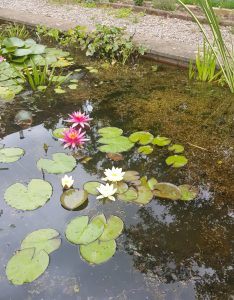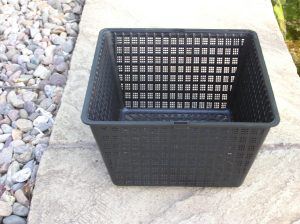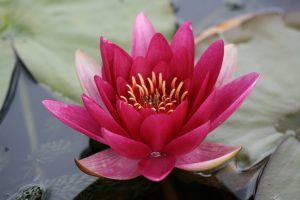Premier among pond plants is the water lily. There are two main groups of water lily in the world, the hardy water lily and the tropical water lily.
Tropical water lilies do not like our climate and are difficult to grow unless you have a specialist tropical greenhouse. Many tropical lilies are night bloomers, some are significantly scented and there is also a wider colour range, including blue, among these cultivars. Indeed, in the USA, where many water lilies are hybridised, it is possible to overwinter tropical lilies, but our experience is that this is a much more challenging and far less rewarding past time in the UK.
A hardy water lily is easy to grow if you just follow a few basic rules. Hardy water lilies come in a wide range of colours from pure white to deepest maroon, powder pink to golden yellow, with flowers from cup to star shaped. They also come in a wide range of sizes from pygmy to large, with flowers from the size of a thimble to a large goblet, and leaves from the size of a 10p coin to the size of a large dinner plate.
There is a water lily suitable for every collection of pond plants, from a tiny tub garden to a large lake. Also, to create a balanced environment for your pond and minimise the invasion of blanket weed, from a third up to half of the surface area should be covered by leaf growth during the peak growing season, for which water lilies are essential.
Where is the best position for a water lily ?
Water lilies like warmth and light, so they will grow best in the sunniest part of the pond. Most water lilies will not flower well in shade although some will tolerate shade as long as they are in sun for more than three hours per day.
Water lilies grow best in still water because they like a constant temperature and don’t like their roots to be disturbed. Plant as far as possible away from any pump or filter system. Moving water will weaken the plant and reduce its flowering.
Never plant a water lily under a fountain as the dropping water will drown and kill it, or immediately next to a waterfall where the constant disturbance will have a similar effect.
How deep should a water lily be planted?

It is a myth that all water lilies need deep water. In fact, unless you are happy to don a wet suit, don’t plant into more than 1m of water as it makes maintenance of the plants a real challenge. Just remember that in your garden pond, at some point you will need to retrieve your water lilies in order to divide and replant them and unless you can breathe under water, accessing them will depend on the length of your arms.
Most water lilies will grow happily with 45 – 60cms of water above the surface of the soil in which they are planted. Obviously pygmy and small water lilies like to be nearer the surface, so pygmy lilies do best with 15 – 25cms of water over the soil and small lilies do best with 20 – 45cms of water over the surface of the soil.
Remember when adding a new, young water lily to your pond, always introduce it gradually to its final depth of water. Never plunge a young plant straight into the bottom of the pond. Start by standing the planting basket on blocks, an old milk crate or some other suitable support so that there is no more than 15cms of water above the soil to start with. When the leaves reach the surface and have built up strength, drop the plant down so that the leaves are just below the surface and repeat until the planting basket is in the final position.
Should I plant my water lily into a planting basket?
Absolutely we would say ‘Yes’ unless you are planting into an earth based lake. At Pondplants HQ we have learnt that the best way to grow water lilies is in a suitable sized mesh planting basket. For a large or medium sized water lily plant into a 10lt basket, for a small or pygmy water lily plant into a 5lt basket.
Water lilies use larger roots to anchor themselves securely in the soil. They will then grow finer roots out through the mesh of the crate to feed from nutrients in the water. This is good for them and great in the fight against blanket weed and other algae.
If you plant into a basket it means that you can, if you need to, move the water lily around in your pond. It also means that you can lift the lily out of the water to divide and re-pot or if necessary top up or replace soil.
If you are looking for a large display of one particular water lily avoid the temptation to plant into a basket larger than 10lt in size. Bitter experience has taught us that such containers, once immersed in water are way too heavy for one person to lift out again! Instead plant three of the same variety of water lily together in a group, with each plant in its own 10lt basket.
What soil should I use for planting my water lily?
If you possibly can, always use clay based garden soil. Heavy loam is ideal and the test is that if you can make the soil into a ball, throw it up and catch it without it disintegrating, then that is the best! It should have the consistency of something like plasticine or putty, not too wet and not too dry.
Don’t use light, sandy or chalky soils as most water lilies prefer a neutral or alkaline environment rather than one that is too acidic. Never add fertilisers or garden compost to the planting medium, as this will encourage the dreaded blanket weed.
If you can’t get hold of any clay based garden soil, then the best you can buy is Arthur Bowers or Westland Aquatic Compost. It is generally available from your local Garden Centre.
How do I plant my water lily?

Water lilies like to have their roots securely anchored, so always be sure to press the soil down really firmly into the basket and around the roots, topping up to within 1-2cms of the rim of the container. Once the soil is firmed down around the plant, top dress with pea gravel to reduce the risk of the soil floating away.
There are several different styles of rhizome (rootstock) for water lilies.
Oderata and tuberosa water lilies such as Helen Fowler and Froebelii, have a rhizome that’s like a knobbly bit of branch, on top are the shoots and below are the roots. When you plant, ¾ fill the 10lt basket with heavy garden loam rammed really firmly into place, then hold the rhizome with shoots uppermost in position in the middle of the basket, with any roots below and firmly secure the roots back filling until the rhizome is on the surface. Then top up so that the top of the rhizome and any shoots are just above the surface of the soil. Top dress with pea gravel making sure not to damage or cover the shoots.
Marliac Water Lilies like Escarboucle, have a rhizome that’s thicker and can look like a small pineapple, with shoots on top and roots growing down from the sides. Again fill to around 2/3rds full a 10lt planting basket with heavy garden loam packed well down. Position the rhizome with shoots uppermost in the middle and pack more soil around it until just the growing tips are exposed. Top dress with pea gravel making sure not to damage or cover the shoots.




